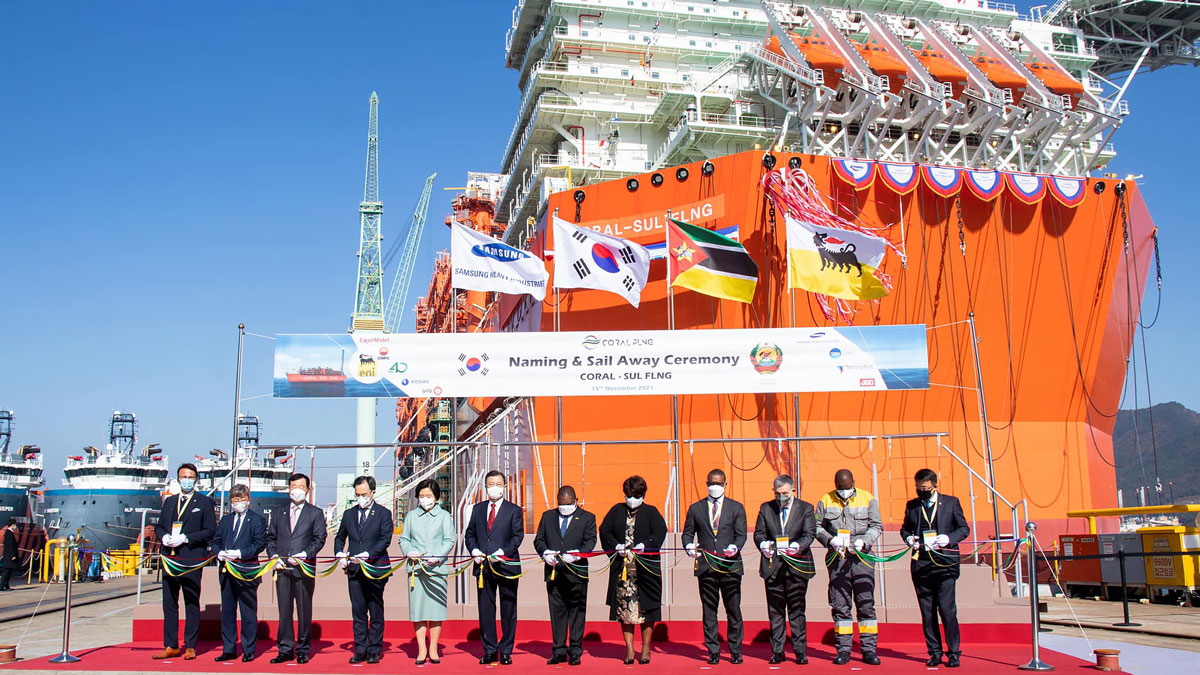Coral-Sul to Produce Carbon-Neutral LNG
Coral-Sul, the world’s 2nd largest Floating Liquefied Natural Gas (FLNG) and the 1st largest FLNG on the African continent has sailed away from South Korea. The naming and sail away ceremony was held with the President Moon Jae-in of South Korea and the president H.E. Filipe Jacinto Nyusi of the Republic of Mozambique on Nov 15 at Samsung heavy industries shipyard in GeoJe. At this ceremony, President Moon Jae-in of South Korea said, “LNG that will be mass-produced by the Coral-Sul FLNG will be a great force in the world’s journey to carbon neutrality.”
Emerson was contracted to provide site installation and commissioning services for the Coral-Sul FLNG facility which will be operated by Eni. Emerson’s smart commissioning tool was utilized to keep the project on schedule even under this pandemic period. Since Mar 2017, Emerson has served as Main Automation Contractor on the Coral-Sul FLNG project, responsible for the supply and implementation of process control and monitoring technologies that will serve Coral-Sul FLNG’s safety and process control. Sail away to Mozambique started on Nov 16 after 21 months of onshore site installation & commissioning activities, and Emerson will continue to support the Coral-Sul FLNG in the next offshore CSU phase in Mozambique.
The Coral-Sul FLNG will start its’ production from the 2nd half of 2022, and it’ll contribute to increase gas availability in a tight market.
Background
Coral South was the first project approved by Eni’s Area 4 partners for developing gas resources discovered in the Rovuma Basin, off Mozambique’s coast. The project involves producing and selling gas from the southern part of the Coral field, using a floating plant for liquefying natural gas (LNG) with a capacity of 3.4 million tonnes, linked to six subsea gas producing wells. In 2016, Eni signed an agreement to sell 100 per cent of LNG production to British Petroleum (BP), and on 1 June 2017, the Italian company embarked on the start-up phase of the project, just three years after drilling the last test well. The liquefied gas is sold by Eni and other Area 4 concessionaires (including CNPC, Galp, Kogas, the Mozambican state company ENH and ExxonMobil through its operator Mozambique Rovuma Venture S.p.A.) to BP, under a 20-year contract with an optional 10-year extension.
The development activities of Area 4 offshore (Eni’s interest 25%) in 2020 concerned the Coral South gas project, operated by Eni, and the gas discoveries of Mamba Complex where Eni is expected to coordinate the upstream development and production phase and ExxonMobil the construction and operation phase of natural gas liquefaction facilities onshore.
In January 2020, Eni and Area 4 partners launched the hull for the Coral Sul Floating Liquefied Natural Gas (FLNG) treatment and liquefaction plant. It will extract 450 billion cubic metres of gas from the field. The hull is 432 metres long by 66 metres wide and weighs in at about 140,000 tonnes. The eight-storey living module, which will accommodate up to 350 people, has been installed. The plant will be the first ever FLNG built for deep waters and the first built specifically for Africa. In 2019, Eni began drilling and completing six subsea wells for feeding the liquefaction units. They will be drilled about 2,000 metres under water and have an average depth of about 3,000 metres.
In November 2020 Eni announced the lifting and installation of the last of the 13 topside modules of the Coral-Sul FLNG facility. The lifting, which marked the end of the onshore-modules fabrication campaign configuring the entire gas treatment and liquefaction plant.
In November 2021 Eni held the naming and sail away ceremony of the Coral-Sul FLNG, the first floating LNG facility ever to be deployed in the deep waters of the African continent. The FLNG will be now towed and moored at its operating site in the Rovuma basin offshore Mozambique. Once the FLNG facility will be in place, the installation campaign will begin, including mooring and hook-up operations at a water-depth of around 2,000 meters by means of 20 mooring lines that totally weight 9,000 tons.







